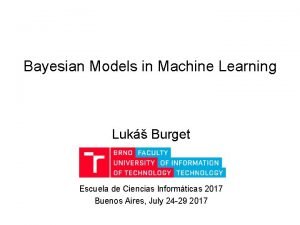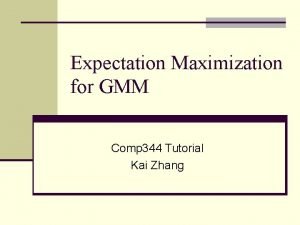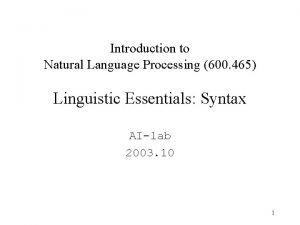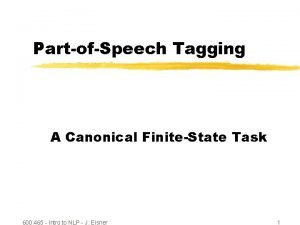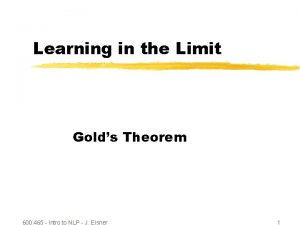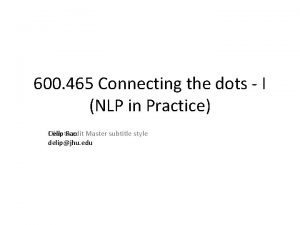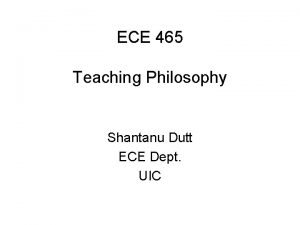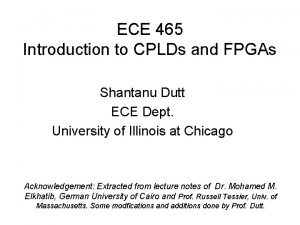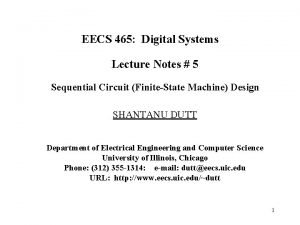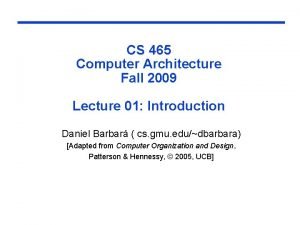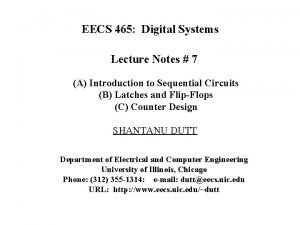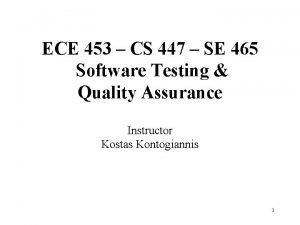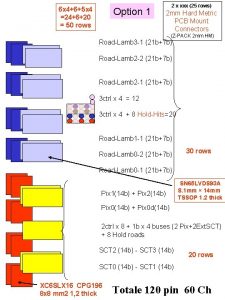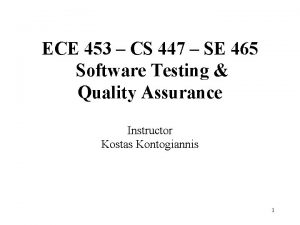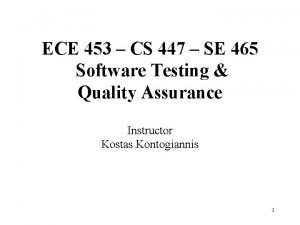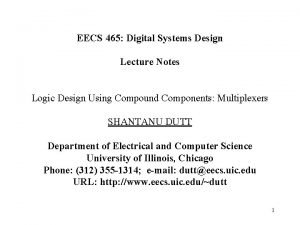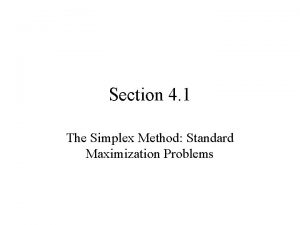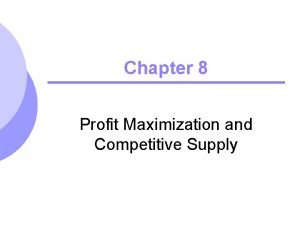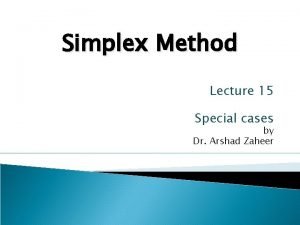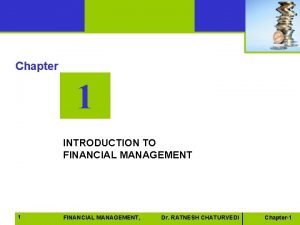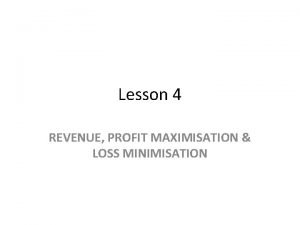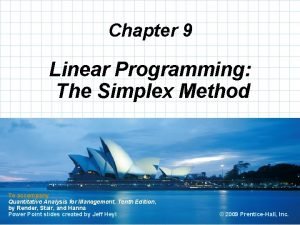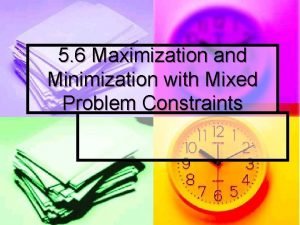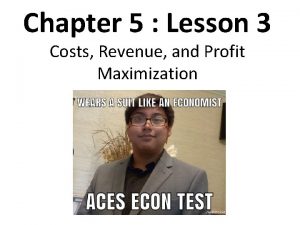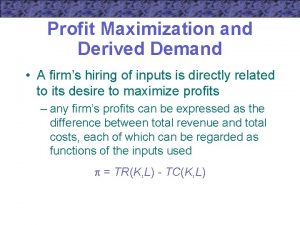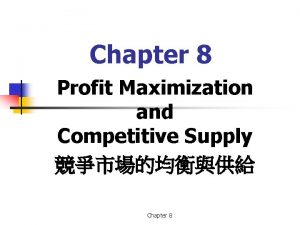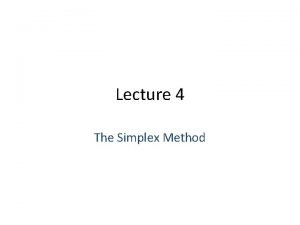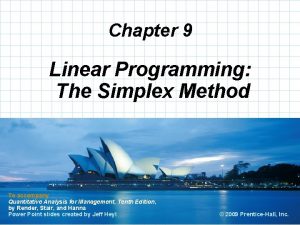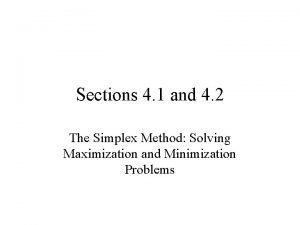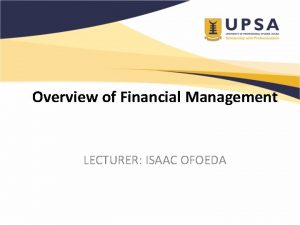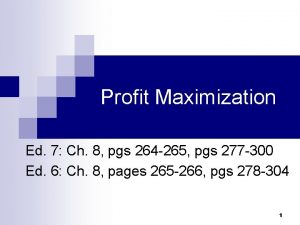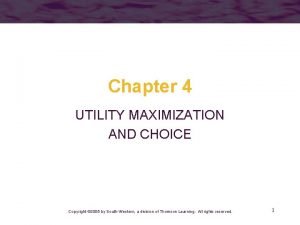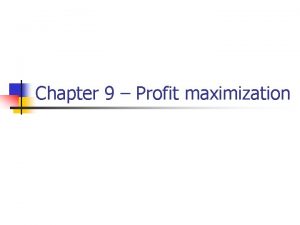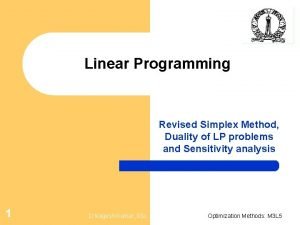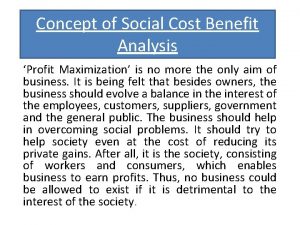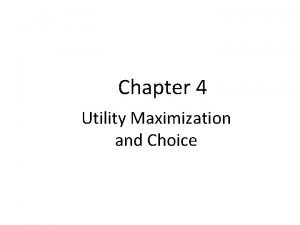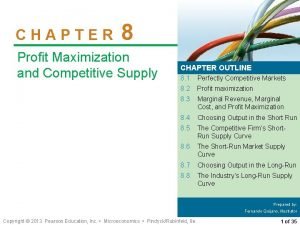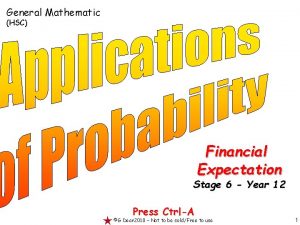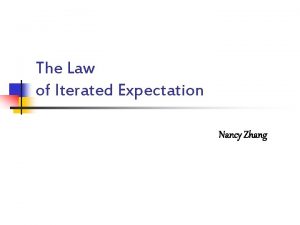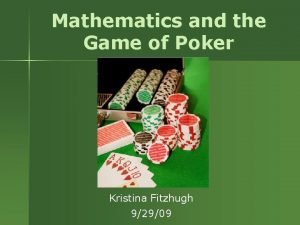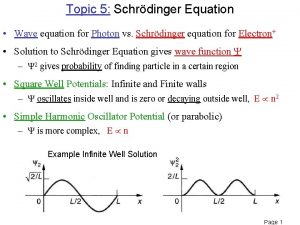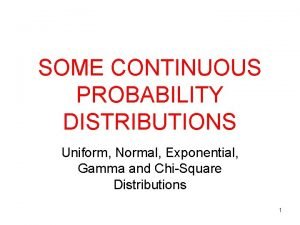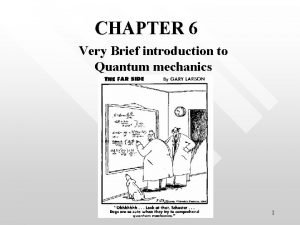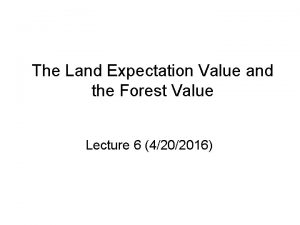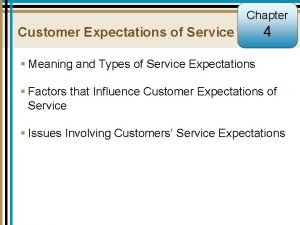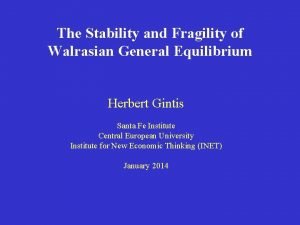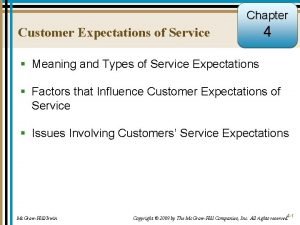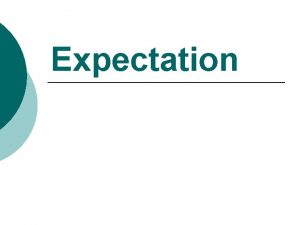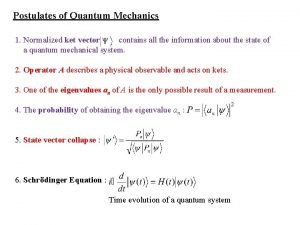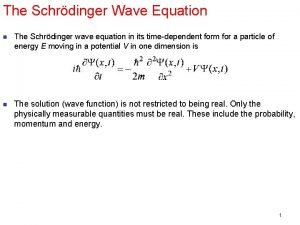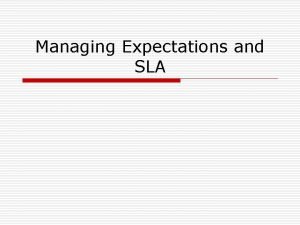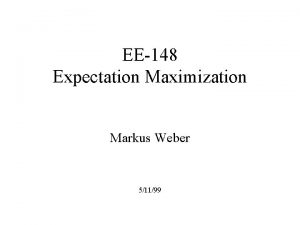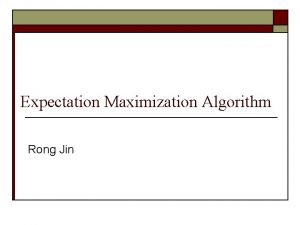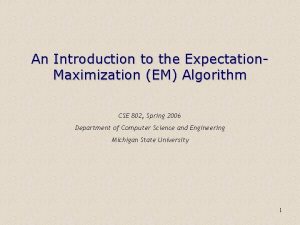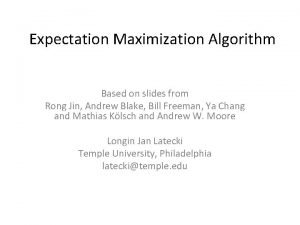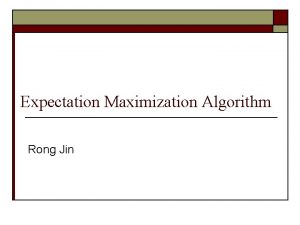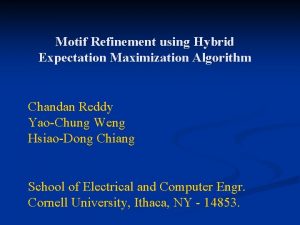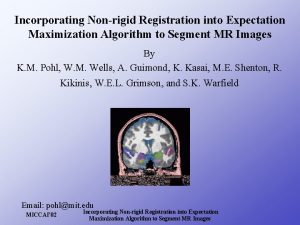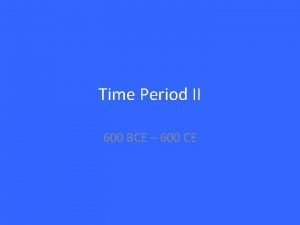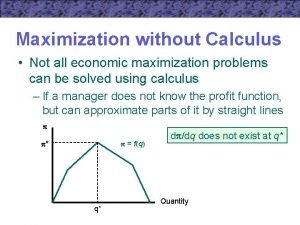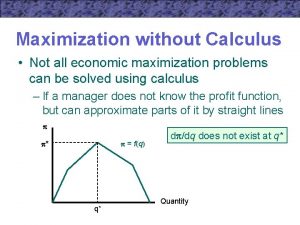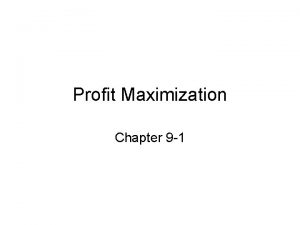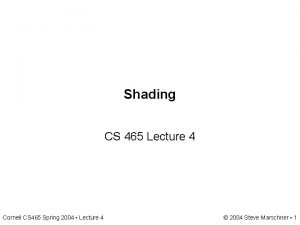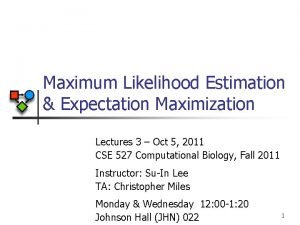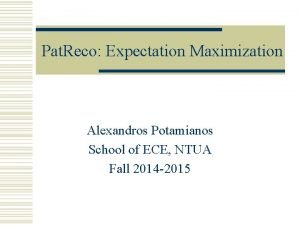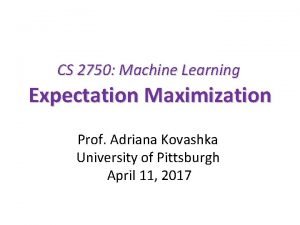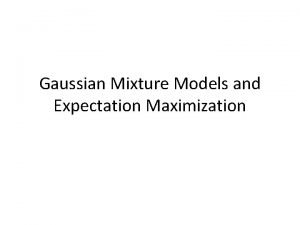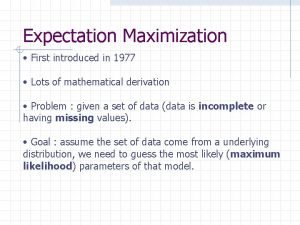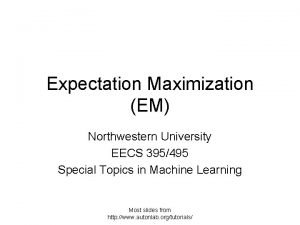The Expectation Maximization EM Algorithm continued 600 465



































































- Slides: 67

The Expectation Maximization (EM) Algorithm … continued! 600. 465 - Intro to NLP - J. Eisner 1

General Idea § Start by devising a noisy channel § Any model that predicts the corpus observations via some hidden structure (tags, parses, …) § Initially guess the parameters of the model! § Educated guess is best, but random can work § Expectation step: Use current parameters (and observations) to reconstruct hidden structure § Maximization step: Use that hidden structure (and observations) to reestimate parameters Repeat until convergence! 600. 465 - Intro to NLP - J. Eisner 2

General Idea initial guess E step Guess of unknown hidden structure Guess of unknown parameters (tags, parses, weather) Observed structure (probabilities) (words, ice cream) M step 600. 465 - Intro to NLP - J. Eisner 3

For Hidden Markov Models initial guess E step Guess of unknown hidden structure Guess of unknown parameters (tags, parses, weather) Observed structure (probabilities) (words, ice cream) M step 600. 465 - Intro to NLP - J. Eisner 4

For Hidden Markov Models initial guess E step Guess of unknown hidden structure Guess of unknown parameters (tags, parses, weather) Observed structure (probabilities) (words, ice cream) M step 600. 465 - Intro to NLP - J. Eisner 5

For Hidden Markov Models initial guess E step Guess of unknown hidden structure Guess of unknown parameters (tags, parses, weather) Observed structure (probabilities) (words, ice cream) M step 600. 465 - Intro to NLP - J. Eisner 6

Grammar Reestimation test sentences E step correct test trees P A R S E R s c o r e r accuracy expensive and/or wrong sublanguage cheap, plentiful Grammar and appropriate LEARNER M step 600. 465 - Intro to NLP - J. Eisner training trees 7

EM by Dynamic Programming: Two Versions § The Viterbi approximation § Expectation: pick the best parse of each sentence § Maximization: retrain on this best-parsed corpus § Advantage: Speed! r? e w y slo § Real EM h w § Expectation: find all parses of each sentence § Maximization: retrain on all parses in proportion to their probability (as if we observed fractional count) § Advantage: p(training corpus) guaranteed to increase § Exponentially many parses, so don’t extract them from chart – need some kind of clever counting 600. 465 - Intro to NLP - J. Eisner 8

Examples of EM § Finite-State case: Hidden Markov Models § “forward-backward” or “Baum-Welch” algorithm § Applications: compose these? § § explain ice cream in terms of underlying weather sequence words in terms of underlying tag sequence phoneme sequence in terms of underlying word sound sequence in terms of underlying phoneme § Context-Free case: Probabilistic CFGs § “inside-outside” algorithm: unsupervised grammar learning! § Explain raw text in terms of underlying cx-free parse § In practice, local maximum problem gets in the way § But can improve a good starting grammar via raw text § Clustering case: explain points via clusters 600. 465 - Intro to NLP - J. Eisner 9

Our old friend PCFG S p( NP VP S time PP V flies P NP like Det N an arrow | ) = p(S NP VP | S) * p(NP time | 600. 465 - Intro to NLP - J. Eisner * p(VP V PP | VP NP ) ) * p(V flies | V) * … 10

Viterbi reestimation for parsing § Start with a “pretty good” grammar § E. g. , it was trained on supervised data (a treebank) that is small, imperfectly annotated, or has sentences in a different S style from what you want to parse. § Parse a corpus of unparsed sentences: # copies of this sentence in the corpus 12 … Today stocks were up … § Reestimate: S Adv. P 12 Today NP VP stocks V were § Collect counts: …; c(S NP VP) += 12; c(S) += 2*12; … § Divide: p(S NP VP | S) = c(S NP VP) / c(S) § May be wise to smooth 600. 465 - Intro to NLP - J. Eisner PRT up 11

True EM for parsing § Similar, but now we consider all parses of each sentence S § Parse our corpus of unparsed sentences: S Adv. P # copies of this sentence in the corpus 12 … Today stocks were up … 10. 8 Today VP stocks V § Collect counts fractionally: § …; c(S NP VP) += 10. 8; c(S) += 2*10. 8; … § …; c(S NP VP) += 1. 2; c(S) += 1*1. 2; … PRT were S 1. 2 NP NP 600. 465 - Intro to NLP - J. Eisner NP up VP NP V Today stocks were PRT up

Where are the constituents? p=0. 5 coal energy expert witness 13

Where are the constituents? p=0. 1 coal energy expert witness 14

Where are the constituents? p=0. 1 coal energy expert witness 15

Where are the constituents? p=0. 1 coal energy expert witness 16

Where are the constituents? p=0. 2 coal energy expert witness 17

Where are the constituents? coal energy expert witness 0. 5 +0. 1+0. 2 = 1 18

Where are NPs, VPs, … ? NP locations VP locations S VP PP NP NP V P Det N Time flies like an arrow 19

Where are NPs, VPs, … ? NP locations Time flies like an VP locations arrow Time flies like an arrow (S (NP Time) (VP flies (PP like (NP an arrow)))) p=0. 5 20

Where are NPs, VPs, … ? NP locations Time flies like an VP locations arrow Time flies like an arrow (S (NP Time flies) (VP like (NP an arrow))) p=0. 3 21

Where are NPs, VPs, … ? NP locations Time flies like an VP locations arrow Time flies like an arrow (S (VP Time (NP flies) (PP like (NP an arrow))))) p=0. 1 22

Where are NPs, VPs, … ? NP locations Time flies like an VP locations arrow Time flies like an arrow (S (VP Time (NP flies)) (PP like (NP an arrow)))) p=0. 1 23

Where are NPs, VPs, … ? NP locations Time flies like an VP locations arrow Time flies 0. 5 +0. 3+0. 1 = 1 like an arrow 24

How many NPs, VPs, … in all? NP locations Time flies like an VP locations arrow Time flies 0. 5 +0. 3+0. 1 = 1 like an arrow 25

How many NPs, VPs, … in all? NP locations Time flies like an 2. 1 NPs (expected) VP locations arrow Time flies like an arrow 1. 1 VPs (expected) 26

Where did the rules apply? S NP VP locations NP Det N locations Time flies like an arrow 27

Where did the rules apply? S NP VP locations NP Det N locations Time flies like an arrow (S (NP Time) (VP flies (PP like (NP an arrow)))) p=0. 5 28

Where is S NP VP substructure? S NP VP locations NP Det N locations Time flies like an arrow (S (NP Time flies) (VP like (NP an arrow))) p=0. 3 29

Where is S NP VP substructure? S NP VP locations NP Det N locations Time flies like an arrow (S (VP Time (NP flies) (PP like (NP an arrow))))) p=0. 1 30

Where is S NP VP substructure? S NP VP locations NP Det N locations Time flies like an arrow (S (VP Time (NP flies)) (PP like (NP an arrow)))) p=0. 1 31

Why do we want this info? § Grammar reestimation by EM method § E step collects those expected counts § M step sets § Minimum Bayes Risk decoding § Find a tree that maximizes expected reward, e. g. , expected total # of correct constituents § CKY-like dynamic programming algorithm § The input specifies the probability of correctness for each possible constituent (e. g. , VP from 1 to 5) 32

Why do we want this info? § Soft features of a sentence for other tasks § NER system asks: “Is there an NP from 0 to 2? ” § True answer is 1 (true) or 0 (false) § But we return 0. 3, averaging over all parses § That’s a perfectly good feature value – can be fed as to a CRF or a neural network as an input feature § Writing tutor system asks: “How many times did the student use S NP[singular] VP[plural]? ” § True answer is in {0, 1, 2, …} § But we return 1. 8, averaging over all parses 33

True EM for parsing § Similar, but now we consider all parses of each sentence S § Parse our corpus of unparsed sentences: S Adv. P # copies of this sentence in the corpus 12 … Today stocks were up … 10. 8 § …; c(S NP VP) += 10. 8; c(S) += 2*10. 8; … § …; c(S NP VP) += 1. 2; c(S) += 1*1. 2; … § How can we stay fast? Similar to taggings… 600. 465 - Intro to NLP - J. Eisner NP VP stocks V § Collect counts fractionally: § But there may be exponentially many parses of a length-n sentence! Today PRT were S 1. 2 NP NP up VP NP V Today stocks were PRT up

Analogies to , in PCFG? The dynamic programming computation of . ( is similar but works back from Stop. ) Day 1: 2 cones Day 2: 3 cones a=0. 1 Start 2|C) ( p * ) t Star | C ( p 0. 1 = 2. 0 0. 5* p(H| Star t)*p( 2|H) 0. 5*0. 2=0. 1 Day 3: 3 cones a=0. 1*0. 08+0. 1*0. 01 =0. 009 a=0. 009*0. 08+0. 063*0. 01 =0. 00135 p(C|C)*p(3|C) C C C 0. 8*0. 1=0. 08 p(H |C) ) | 3 C C ( | 0. 1 )*p (3| 1 0. 1 C)*p 0. 01 p (3| H * *0. | ( *0. . 0 H H) 7= 7= 3|H) p(C *0. 1= 0. 0 ) p(C| 0. 1=0 0. 07 * 7 0. 1 1. 0 p(H|H)*p(3|H) H H H 0. 8*0. 7=0. 56 a=0. 1*0. 07+0. 1*0. 56 a=0. 009*0. 07+0. 063*0. 56 =0. 063 =0. 03591 Call these H(2) and H(2) 600. 465 - Intro to NLP - J. Eisner H(3) and H(3) 35

“Inside Probabilities” S p( NP VP S time PP V flies P NP like Det N an arrow | ) = p(S NP VP | S) * p(NP time | * p(VP V PP | VP NP ) ) * p(V flies | V) * … § Sum over all VP parses of “flies like an arrow”: VP(1, 5) = p(flies like an arrow | VP ) § Sum over all S parses of “time flies like an arrow”: S(0, 5) = p(time flies like an arrow | S) 600. 465 - Intro to NLP - J. Eisner 36

Compute Bottom-Up by CKY S p( NP VP S time PP V flies P NP like Det N an arrow | ) = p(S NP VP | S) * p(NP time | * p(VP V PP | VP NP ) ) * p(V flies | V) * … VP(1, 5) = p(flies like an arrow | VP )=… S(0, 5) = p(time flies like an arrow | S) = NP(0, 1) * VP(1, 5) * p(S NP VP|S) + … 600. 465 - Intro to NLP - J. Eisner 37

Compute Bottom-Up by CKY time 1 flies 2 NP 3 Vst 3 like 3 an 4 NP 10 S 8 S 13 NP NP S S S 0 1 2 3 4 arrow NP 4 VP 4 5 24 24 22 27 27 NP 18 S 21 VP 18 P 2 V 5 1 VP V NP 2 VP PP NP 10 1 NP Det N 2 NP PP 3 NP NP N 0 PP P NP PP 12 VP 16 Det 1 1 S NP VP 6 S Vst NP 2 S S PP 8

Compute Bottom-Up by CKY time 1 flies 2 like 3 NP 2 -10 Vst 2 -3 S 2 -8 S 2 -13 NP 2 -4 VP 2 -4 3 4 4 arrow NP NP S S 0 2 an 5 2 -24 2 -22 2 -27 2 -22 NP 2 -18 S 2 -21 VP 2 -18 P 2 -2 V 2 -5 PP 2 -12 VP 2 -16 Det 2 -1 NP 2 -10 N 2 -8 S NP VP 2 -6 S Vst NP 2 -2 S S PP 2 -1 VP V NP 2 -2 VP PP 2 -1 NP Det N 2 -2 NP PP 2 -3 NP NP 2 -1 2 -0 PP P NP

Compute Bottom-Up by CKY time 1 flies 2 like 3 NP 2 -10 Vst 2 -3 S 2 -8 S 2 -13 0 NP 2 -4 VP 2 -4 2 3 4 P 2 -2 V 2 -5 an 4 arrow 5 NP NP S S S 2 -24 2 -22 2 -27 S S NP S VP 2 -22 2 -27 2 -18 2 -21 2 -18 PP 2 -12 VP 2 -16 Det 2 -1 NP 2 -10 N 2 -8 S NP VP 2 -6 S Vst NP 2 -2 S S PP 2 -1 VP V NP 2 -2 VP PP 2 -1 NP Det N 2 -2 NP PP 2 -3 NP NP 2 -1 2 -0 PP P NP

The Efficient Version: Add as we go time 1 flies 2 like 3 NP 2 -10 Vst 2 -3 S 2 -8 S 2 -13 NP 2 -4 VP 2 -4 3 4 4 arrow NP NP S S S 0 2 an 5 2 -24 2 -22 2 -27 NP 2 -18 S 2 -21 VP 2 -18 P 2 -2 V 2 -5 PP 2 -12 VP 2 -16 Det 2 -1 NP 2 -10 N 2 -8 S NP VP 2 -6 S Vst NP 2 -2 S S PP 2 -1 VP V NP 2 -2 VP PP 2 -1 NP Det N 2 -2 NP PP 2 -3 NP NP 2 -1 2 -0 PP P NP

The Efficient Version: Add as we go time 1 flies 2 like NP 2 -3 NP 2 -10 Vst 2 -3 S 2 -8 +2 -13 0 3 an 4 S(0, 2) s(0, 2)* PP(2, 5)*p(S S PP | S) 3 4 5 NP 2 -24 +2 -24 S 2 -22 +2 -27 +2 -22 +2 -27 NP 2 -18 S 2 -21 VP 2 -18 NP 2 -4 VP 2 -4 2 arrow P 2 -2 V 2 -5 PP(2, 5) PP 2 -12 VP 2 -16 Det 2 -1 NP 2 -10 N 2 -8 s(0, 5) S NP VP 2 -6 S Vst NP 2 -2 S S PP 2 -1 VP V NP 2 -2 VP PP 2 -1 NP Det N 2 -2 NP PP 2 -3 NP NP 2 -1 2 -0 PP P NP

Compute probs bottom-up (CKY) need some initialization up here for the width-1 case for width : = 2 to n (* build smallest first *) for i : = 0 to n-width (* start *) let k : = i + width (* end *) for j : = i+1 to k-1 (* middle *) for all grammar rules X Y Z X(i, k) += p(X Y Z | X) * Y(i, j) * Z(j, k) X Y i Z j k what if you changed + to max? 600. 465 - Intro to NLP - J. Eisner what if you replaced all rule probabilities by 1? 43

Inside & Outside Probabilities S P NP VP time VP V flies “outs VP(1, 5) = p(time VP today | S) NP today PP P NP like Det N an arrow “inside” V e h t ” ide VP(1, 5) = p(flies like an arrow | VP) VP(1, 5) * VP(1, 5) = p(time [VP flies like an arrow] today | S) the VP 600. 465 - Intro to NLP - J. Eisner 44

Inside & Outside Probabilities S NP VP time VP V flies NP today PP VP(1, 5) = p(time VP today | S) P NP like Det N an arrow VP(1, 5) = p(flies like an arrow | VP) VP(1, 5) * VP(1, 5) / S(0, 6) = p(time flies like an arrow today & VP(1, 5) | S) p(time flies like an arrow today | S) = p(VP(1, 5) | time flies like an arrow today, S) 600. 465 - Intro to NLP - J. Eisner 45

Inside & Outside Probabilities S NP VP time VP V flies NP today PP VP(1, 5) = p(time VP today | S) P NP like Det N an arrow VP(1, 5) = p(flies like an arrow | VP) strictly analogous to forward-backward in the finite-state case! So VP(1, 5) * VP(1, 5) / s(0, 6) is probability that there is a VP here, given all of the observed data (words) C C C H H H Start 600. 465 - Intro to NLP - J. Eisner 46

Inside & Outside Probabilities S NP VP time VP V flies NP today PP VP(1, 5) = p(time VP today | S) P NP like Det N an arrow V(1, 2) = p(flies | V) PP(2, 5) = p(like an arrow | PP) So VP(1, 5) * V(1, 2) * PP(2, 5) / s(0, 6) is probability that there is VP V PP here, given all of the observed data (words) … 600. 465 - Intro to NLP - J. Eisner or is it? 47

Inside & Outside Probabilities S NP VP time VP V flies NP today PP strictly analogous to forward-backward in the finite-state case! VP(1, 5) = p(time VP today | S) P NP like Det N an arrow C C H H Start V(1, 2) = p(flies | V) PP(2, 5) = p(like an arrow | PP) sum prob over all position triples like (1, 2, 5) to get expected c(VP V PP); reestimate PCFG! So VP(1, 5) * p(VP V PP) * V(1, 2) * PP(2, 5) / s(0, 6) is probability that there is VP V PP here (at 1 -2 -5), given all of the observed data (words) 600. 465 - Intro to NLP - J. Eisner 48

Compute probs bottom-up (gradually build up larger blue “inside” regions) Summary: VP(1, 5) += p(V PP | VP) * V(1, 2) * PP(2, 5) inside 1, 5 p(flies like an arrow | VP) += inside 1, 2 inside 2, 5 VP(1, 5) VP p(V PP | VP) * p(flies | V) * p(like an arrow | PP) PP V(1, 2) V flies PP(2, 5) P like NP Det an 600. 465 - Intro to NLP - J. Eisner N arrow 49

Compute probs top-down (uses probs Summary: V(1, 2) += p(V PP as | VP)well) * VP(1, 5) * PP(2, 5) outside 1, 2 S outside 1, 5 (gradually build up larger pink “outside” regions) p(time V like an arrow today | S) NP time += p(time VP today | S) * p(V PP | VP) * p(like an arrow | PP) 600. 465 - Intro to NLP - J. Eisner VP VP(1, 5) VP V(1, 2) inside 2, 5 NP today PP V flies PP(2, 5) P like NP Det an N arrow 50

Compute probs top-down (uses += probs well) Summary: PP(2, 5) p(V PPas | VP) * VP(1, 5) * V(1, 2) S outside 2, 5 NP time inside 1, 2 VP VP(1, 5) VP V(1, 2) outside 1, 5 NP today PP V flies p(time flies PP today | S) PP(2, 5) P like += p(time VP today | S) NP * p(V PP | VP) Det an 600. 465 - Intro to NLP - J. Eisner N arrow * p(flies| V) 51

Details: Compute probs bottom-up When you build VP(1, 5), from VP(1, 2) and VP(2, 5) during CKY, increment VP(1, 5) by p(VP VP PP) * VP(1, 2) * PP(2, 5) Why? VP(1, 5) is total probability of all derivations p(flies like an arrow | VP) and we just found another. (See earlier slide of CKY chart. ) 600. 465 - Intro to NLP - J. Eisner VP(1, 5) VP VP(1, 2) VP PP PP(2, 5) flies P like NP Det an N arrow 52

Details: Compute probs bottom-up (CKY) for width : = 2 to n (* build smallest first *) for i : = 0 to n-width (* start *) let k : = i + width (* end *) for j : = i+1 to k-1 (* middle *) for all grammar rules X Y Z X(i, k) += p(X Y Z) * Y(i, j) * Z(j, k) X Y i Z j k 600. 465 - Intro to NLP - J. Eisner 53

Details: Compute probs top-down (reverse CKY) n downto 2 “unbuild” biggest first (* build smallest first *) for width : = 2 to n for i : = 0 to n-width (* start *) let k : = i + width (* end *) for j : = i+1 to k-1 (* middle *) for all grammar rules X Y Z Y(i, j) += ? ? ? X Z(j, k) += ? ? ? Y i Z j k 600. 465 - Intro to NLP - J. Eisner 54

Details: Compute probs top-down (reverse CKY) After computing during CKY, revisit constits in reverse order (i. e. , bigger constituents first). S NP time VP When you “unbuild” VP(1, 5) from VP(1, 2) and VP(2, 5), VP(1, 5) VP NP increment VP(1, 2) by today VP(1, 5) * p(VP VP PP) * PP(2, 5) PP PP(2, 5) VP(1, 2) VP and increment PP(2, 5) by VP(1, 2) PP(2, 5) VP(1, 5) * p(VP VP PP) * already computed on bottom-up pass VP(1, 2) is total prob of all ways to gen VP(1, 2) and all outside words. 600. 465 - Intro to NLP - J. Eisner 55

Details: Compute probs top-down (reverse CKY) n downto 2 “unbuild” biggest first (* build smallest first *) for width : = 2 to n for i : = 0 to n-width (* start *) let k : = i + width (* end *) for j : = i+1 to k-1 (* middle *) for all grammar rules X Y Z Y(i, j) += X(i, k) * p(X Y Z) * Z(j, k) X Z(j, k) += X(i, k) * p(X Y Z) * Y(i, j) Y i Z j k 600. 465 - Intro to NLP - J. Eisner 56

What Inside-Outside is Good For 1. As the E step in the EM training algorithm 2. Predicting which nonterminals are probably where 3. Viterbi version as an A* or pruning heuristic 4. As a subroutine within non-context-free models

What Inside-Outside is Good For 1. As the E step in the EM training algorithm S § That’s why we just did it S Adv. P 12 … Today stocks were up … 10. 8 Today NP VP stocks V c(S) = i, j S(i, j)/Z were S 1. 2 c(S NP VP) = i, j, k S(i, k) p(S NP VP) NP(i, j) VP(j, k)/Z where Z = total prob of all parses = S(0, n) PRT up NP NP V Today stocks were PRT up

Does Unsupervised Learning Work? § Merialdo (1994) § “The paper that freaked me out …” - Kevin Knight § EM always improves likelihood § But it sometimes hurts accuracy § Why? #@!? 600. 465 - Intro to NLP - J. Eisner 59

Does Unsupervised Learning Work? 600. 465 - Intro to NLP - J. Eisner 60

What Inside-Outside is Good For 1. As the E step in the EM training algorithm 2. Predicting which nonterminals are probably where § Posterior decoding of a single sentence § § Like using to pick the most probable tag for each word But can’t just pick most probable nonterminal for each span … § § So, find the tree that maximizes expected # correct nonterms. § § Alternatively, expected # of correct rules. For each nonterminal (or rule), at each position: § § § Wouldn’t get a tree! (Not all spans are constituents. ) tells you the probability that it’s correct. For a given tree, sum these probabilities over all positions to get that tree’s expected # of correct nonterminals (or rules). How can we find the tree that maximizes this sum? § Dynamic programming – just weighted CKY all over again.

What Inside-Outside is Good For 1. As the E step in the EM training algorithm 2. Predicting which nonterminals are probably where § § Posterior decoding of a single sentence As soft features in a predictive classifier § § § You want to predict whether the substring from i to j is a name Feature 17 asks whether your parser thinks it’s an NP If you’re sure it’s an NP, the feature fires § § If you’re sure it’s not an NP, the feature doesn’t fire § § add 1 17 to the log-probability add 0 17 to the log-probability But you’re not sure! § The chance there’s an NP there is p = NP(i, j)/Z § So add p 17 to the log-probability

What Inside-Outside is Good For 1. As the E step in the EM training algorithm 2. Predicting which nonterminals are probably where § § § Posterior decoding of a single sentence As soft features in a predictive classifier Pruning the parse forest of a sentence § § § To build a packed forest of all parse trees, keep all backpointer pairs Can be useful for subsequent processing § Provides a set of possible parse trees to consider for machine translation, semantic interpretation, or finer-grained parsing § But a packed forest has size O(n 3); single parse has size O(n) To speed up subsequent processing, prune forest to manageable size § Keep only constits with prob /Z ≥ 0. 01 of being in true parse § Or keep only constits for which /Z ≥ (0. 01 prob of best parse) § I. e. , do Viterbi inside-outside, and keep only constits from parses

What Inside-Outside is Good For 1. As the E step in the EM training algorithm 2. Predicting which nonterminals are probably where 3. Viterbi version as an A* or pruning heuristic § § Viterbi inside-outside uses a semiring with max in place of + § Call the resulting quantities , instead of , (as for HMM) Prob of best parse that contains a constituent x is (x) § § § Suppose the best overall parse has prob p. Then all its constituents have (x)=p, and all other constituents have (x) < p. So if we only knew (x) < p, we could skip working on x. In the parsing tricks lecture, we wanted to prioritize or prune x according to “p(x) q(x). ” We now see better what q(x) was: § § p(x) was just the Viterbi inside probability: p(x) = (x) q(x) was just an estimate of the Viterbi outside prob: q(x) (x).

What Inside-Outside is Good For 1. As the E step in the EM training algorithm 2. Predicting which nonterminals are probably where 3. Viterbi version as an A* or pruning heuristic § § [continued] q(x) was just an estimate of the Viterbi outside prob: q(x) (x). § If we could define q(x) = (x) exactly, prioritization would first process the constituents with maximum , which are just the correct ones! So we would do no unnecessary work. § § But to compute (outside pass), we’d first have to finish parsing (since depends on from the inside pass). So this isn’t really a “speedup”: it tries everything to find out what’s necessary. But if we can guarantee q(x) ≥ (x), get a safe A* algorithm. § We can find such q(x) values by first running Viterbi inside-outside

What Inside-Outside is Good For 1. As the E step in the EM training algorithm 2. Predicting which nonterminals are probably where 3. Viterbi version as an A* or pruning heuristic § § 0. 6 0. 3 0 0 0. 1 S S S [continued] If we can guarantee q(x) ≥ (x), get a safe A* algorithm. § We can find such q(x) values by first running Viterbi insideoutside on the sentence maxusing a faster approximate grammar. NP[sing] NP[plur] VP[stem] … VP[sing] VP[plur] VP[sing] 0. 6 S NP[? ] VP[? ] This “coarse” grammar ignores features and makes optimistic assumptions about how they will turn out. Few nonterminals, so fast. Now define q. NP[sing](i, j) = q. NP[plur](i, j) = NP[? ](i, j)

What Inside-Outside is Good For 1. 2. 3. 4. As the E step in the EM training algorithm Predicting which nonterminals are probably where Viterbi version as an A* or pruning heuristic As a subroutine within non-context-free models § § § We’ve always defined the weight of a parse tree as the sum of its rules’ weights. Advanced topic: Can do better by considering additional features of the tree (“non-local features”), e. g. , within a log-linear model. CKY no longer works for finding the best parse. § § Approximate “reranking” algorithm: Using a simplified model that uses only local features, use CKY to find a parse forest. Extract the best 1000 parses. Then re-score these 1000 parses using the full model. Better approximate and exact algorithms: Beyond scope of this course. But they usually call inside-outside or Viterbi inside-outside as a subroutine, often several times (on multiple variants of the grammar, where again each variant can only use local features).
 Expectation maximization algorithm
Expectation maximization algorithm Expectation maximization tutorial
Expectation maximization tutorial 600-465
600-465 600-465
600-465 Gold's theorem
Gold's theorem 600-465
600-465 Rumus segitig
Rumus segitig Se 465
Se 465 Ece 368
Ece 368 Abiturzulassung
Abiturzulassung Neighborhood integration testing
Neighborhood integration testing Ece 465
Ece 465 Eecs 465
Eecs 465 Cs 465 gmu
Cs 465 gmu Eecs 465
Eecs 465 Weak equivalence class testing
Weak equivalence class testing Eecs 465
Eecs 465 465 x 4
465 x 4 Se 465
Se 465 Dd path testing
Dd path testing Eecs 465
Eecs 465 Standard maximization problem
Standard maximization problem Profit maximizing output
Profit maximizing output Simplex special cases
Simplex special cases Profit maximization in financial management
Profit maximization in financial management Profit maximizing output
Profit maximizing output What cj-zj represents
What cj-zj represents Big m method maximization example
Big m method maximization example Lesson 3 cost revenue and profit maximization
Lesson 3 cost revenue and profit maximization Monopsony profit maximization
Monopsony profit maximization Profit maximization and competitive supply
Profit maximization and competitive supply Marginal revenue
Marginal revenue Customer lifetime value maximization
Customer lifetime value maximization Simplex
Simplex In simplex table the pivot row is computed by
In simplex table the pivot row is computed by Revised simplex calculator
Revised simplex calculator Limitations of profit maximization
Limitations of profit maximization Profit maximization
Profit maximization Definition
Definition Utility maximization problem
Utility maximization problem Accounting profit vs economic profit
Accounting profit vs economic profit Utility maximization
Utility maximization Module 53 featured worksheet profit maximization
Module 53 featured worksheet profit maximization Revised dual simplex method
Revised dual simplex method Abt model of social accounting
Abt model of social accounting Perfect substitutes utility function
Perfect substitutes utility function Profit maximization and competitive supply
Profit maximization and competitive supply Expectation in general mathematics
Expectation in general mathematics Possible levels of customer expectations
Possible levels of customer expectations The law of iterated expectation
The law of iterated expectation Poker kryterialny
Poker kryterialny Dual customer expectation levels
Dual customer expectation levels Conclusion for communication
Conclusion for communication Uniform distribution formula
Uniform distribution formula The midwives prayer
The midwives prayer Schrodinger wave equation
Schrodinger wave equation Service level expectation
Service level expectation The uniform, normal, and exponential distributions
The uniform, normal, and exponential distributions Expectation value in quantum mechanics
Expectation value in quantum mechanics Land expectation value calculator
Land expectation value calculator Possible levels of customer expectations
Possible levels of customer expectations Expectation of gamma distribution
Expectation of gamma distribution Rational expectation equilibrium
Rational expectation equilibrium Dual customer expectation levels
Dual customer expectation levels Expectation value
Expectation value Normalize vector
Normalize vector Wave reflection formula
Wave reflection formula Sla expectations
Sla expectations
